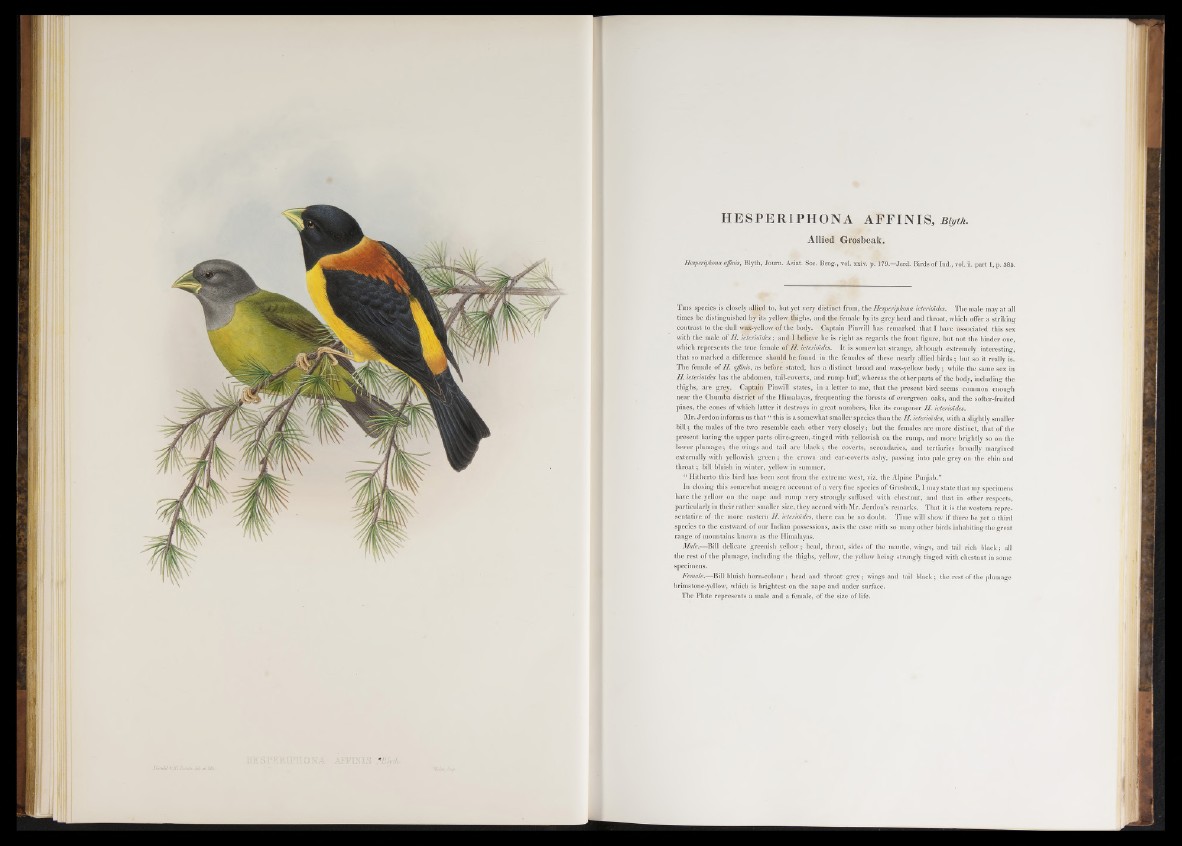
HE S P ER1PH0 NA AFFINIS , Biyth.
Allied Grosbeak.
Hesperiphona affinis, Blyth, Jo um . Asiat. Soc. Beng., vol. xxiv. p. 179.—Jerd. Birds o f Ind., vol. ii. p a r t 1, p. 385.
T h i s species is closely allied to, but yet very distinct from, the Hesperiphona icterioides. The male may at all
times he distinguished limits yellow thighs, and the female by its grey head and throat, which offer a striking
contrast to the dull wax-yellow of the body. Captain Pinwill has remarked that I have associated this sex
with the male of II. icterioides; and I believe he is right as regards the front figure, but not the hinder one,
which represents the true female o f H. icterioides. It is somewhat strange, although extremely interesting,
th at so marked a difference shoiild be found in the females of these nearly allied b irds; but so it really is.
The female of H. affinis, as before stated, has a distinct broad and wax-yellow body; while the same sex in
H. icterioides has the abdomen, tail-coverts, and rump buff, whereas the other parts o f the body, including the
thighs, are grey. Captain Pinwill states, in a letter to me, that the present bird seems common enough
near the Chumba district of the Himalayas, frequenting the forests o f evergreen oaks, and the softer-fruited
pines, the cones of which latter it destroys in great numbers, like its congener H icterioides.
Mr. Jerdon informs us that “ this is a somewhat smaller species than the H. icterioides, with a slightly smaller
b ill; the males o f the two resemble each other very closely; but the females are more distinct, that of the
present having the upper parts olive-green,-tinged with yellowish on the rump, and more brightly so on the
lower plumage; the wings and tail are black; the coverts, secondaries, and tertiaries broadly margined
externally with yellowish green ; the crown and ear-coverts ashy, passing into pale grey on the chin and
th ro a t; bill bluish in winter, yellow in summer.
“ H itherto this bird has been sent from the extreme west, viz. the Alpine Punjab,^
In closing this somewhat meagre account of a very fine species of Grosbeak, I may state that my specimens
have the yellow on the nape and rump very strongly suffused with chestnut, and that in other respects,
particularly in their rather smaller size, they accord with M r. Jerdon’s remarks. That it is the western representative
o f the more eastern H icterioides, there can be no doubt. Time will show if there be yet a third
species to the eastward of our Indian possessions, as is the case with so many other birds inhabiting the great
range o f mountains known as the Himalayas.
Male.—Bill delicate greenish yellow; head, throat, sides of the mantle, wings, and tail rich black; all
the rest of the plumage, including the thighs, yellow, the yellow being strongly tinged with chestnut in some
specimens.
Female.—Bill bluish horn-colour; head and throat g rey ; wings and tail black; the rest o f the plumage
brimstone-yellow, which is brightest on the nape and under surface.
The Plate represents a male and a female, o f the size of life.